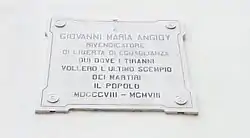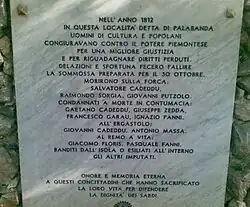Sa die de sa Sardigna
Sardinia's Day (Sardinian: sa die de sa Sardigna [sa ˈði.ɛ ðɛ za zaɾˈdiɲːa]; Sassarese: la dì di la Sardigna; Gallurese: la dì di la Saldigna; Algherese: lo dia de la Sardenya; Italian: il giorno della Sardegna), also known as Sardinian people's Day (Italian: Giornata del popolo sardo), is a holiday in Sardinia commemorating the Sardinian Vespers occurring in 1794–96.
| Sardinia's Day | |
|---|---|
 G. Maria Angioy enters Sassari (1795) | |
| Official name | Sa die de sa Sardigna (Sardinian) |
| Also called | Giornata del popolo sardo (Sardinian people's Day) |
| Observed by | Sardinia, Italy |
| Significance | Commemorates the Sardinian Vespers |
| Date | April 28 |
| Frequency | annual |
History
In the last decades of the 18th century following the Savoyard take-over of the island and the once Spanish Kingdom, tensions had begun to mount among the Sardinians towards the Piedmontese administration.[1][2][3] Sardinian peasants resented the feudal rule and both the local nobles and the bourgeoisie were being left out of any active civil and military role, with the viceroy and other people from the Italian mainland being appointed in charge of the island. Such political unrest was bolstered further by the international situation, with particular regard to the ferment developing in other European regions (namely Ireland, Poland, Belgium, Hungary, Tyrol) and the episodes leading to the French Revolution.
In 1793, a French fleet tried to conquer the island along two lines of attack, the first one across the southern coast in Cagliari[4] and the other in the nearby of the Maddalena archipelago. However, the locals managed to resist the invasion by the French, and began expecting the Savoyards to acknowledge the feat and improve their condition in return. The Sardinians thus presented with the King a list of grievances requiring his remedy, amongst which the demand that most of the offices be reserved for native Sardinians, along with autonomy from the Savoyard ruling class.[5]

Insurrection
The King's peremptory refusal to grant the island any of these wishes[6][7] eventually spurred the rebellion against Piedmont's primacy within the Kingdom, with the arrest of two notable figures of the so-called "Patriotic Party" (the lawyers from Cagliari Vincenzo Cabras and Efisio Pintor) being the final spark of unrest amongst the populace.
On 28 April 1794, known as sa dii de s'aciappa[8] ("the day of the pursuit and capture"), people in Cagliari started chasing any Piedmontese functionaries they could find; since many of them started to wear the local robes in order to blend into the crowd, any people suspected to be from the Italian mainland would be asked by the populace to "say chickpea" (nara cixiri) in Sardinian: failure in pronouncing the word correctly would give their origin away. By May, all the 514 Savoyard officers were put on a boat and sent back to the mainland. Encouraged by what happened in Cagliari, the people in Sassari and Alghero did the same,[9] and the revolt spread throughout the rest of the island in the countryside.
Thus, Sardinia became the first European country to have engaged in a revolution of its own, the episode not being the result of a foreign military importation like in most of Europe.[10]


End
The uprising was then led for another two years by the republican Giovanni Maria Angioy, then a judge of the Royal Hearing (Reale Udienza), but it was later repressed by the loyalist forces that became bolstered by the peace treaty between France and Piedmont in 1796.[11] The revolutionary experiment was thus brought to an end and Sardinia remained under Savoyard rule.[12][13][14]
A period of restoration of the monarchical and aristocratic values would follow the Sardinian revolution,[15] culminating in the Perfect Fusion between the island and the mainland; however, they did not manage to crack down on a couple of localized but significant antifeudal revolts that would arise, from time to time, up until 1821, like the so-called "Palabanda's Conspiracy" in Cagliari of 1812[16] and the rebellion in Alghero of 1821.[17]
Institutionalization of the date
The actual date was chosen in 1993[18] and public events are being annually held to commemorate the episode, while the schools are closed.
See also
- Su patriottu sardu a sos feudatarios, official Sardinian hymn and a revolutionary anthem
- History of Sardinia
Notes
- "The resentment of the Sardinian Nation towards the Piedmontese had been growing for more than half a century, when they [Piedmontese] began to keep for themselves all the lucrative employments on the island, to violate the ancient privileges granted to the Sardinians by the Kings of Aragon, to promote to the highest positions people of their own kind while leaving to the Sardinians only the episcopates of Ales, Bosa and Castelsardo, that is Ampurias. The arrongance and scorn with which the Piedmontese had been treating the Sardinians by calling them bums, dirty, cowards and other similar and irritating names, and above all the most common expression of Sardi molenti, that is "Sardinian donkeys", did little but worsen their disposition as the days passed, and gradually alienated them from this nation." Tommaso Napoli, Relazione ragionata della sollevazione di Cagliari e del Regno di Sardegna contro i Piemontesi
- "The hostility against the Piedmontese was no longer a matter of employments, like the last period of Spanish rule, the dispatches of the viceroy Balbiano and the demands of the Stamenti may paint it out to be. The Sardinians wanted to get rid of them not only because they stood as a symbol of an anachronistic dominion, hostile to both the autonomy and the progress of the island, but also and perhaps especially because their presumptuosness and intrusiveness had already become insufferable." Raimondo Carta Raspi, Storia della Sardegna, Editore Mursia, Milano, 1971, pp.793
- "Che qualcosa bollisse in pentola, in Sardegna, poteva essere compreso fin dal 1780. Molte delle recriminazioni contro il governo piemontese erano ormai più che mature, con una casistica di atti, fatti, circostanze a sostenerle, tanto per la classe aristocratica, quanto per le altre componenti sociali." Onnis, Omar (2015). La Sardegna e i sardi nel tempo, Arkadia, Cagliari, p.149
- Tommaso Napoli, Relazione di quanto è avvenuto dalla comparsa della flotta francese in Cagliari sino alla totale ritirata di essa nel 1793/94
- Concerning the colonial-like (Girolamo Sotgiu, Storia della Sardegna sabauda, Editore La Terza, Roma-Bari, 1984, pp.76) relation of formal as well as substantial dependence of the local viceroy from the central power in the mainland: "The instructions did not draw a general direction of government policy to be observed in the island's affairs, but instead set, with meticulous pedantry, a number of duties that made the viceroy a bureaucratic executor of orders who was denied any possibility of self-initiative. Therefore, the viceroy did not have any political role to fulfill, but just bureaucratic obligations to perform. All the power was in fact concentrated in Turin and the viceroy was a mere missus dominici, who was not allowed to go beyond rather rigid instructions. As to make the viceroy's position even less effective, the viceroy's prerogatives had been weakened even more than under Spanish rule, although it was not given public notice of such a fact, out of prudence." Girolamo Sotgiu, Storia della Sardegna sabauda, Editore La Terza, Roma-Bari, 1984, pp.25
- "The meaning was clear: more than a humiliation to the members of the Stamenti, it ought to be considered a warning to the Sardinians, who were not allowed to ask more than what they received from the king: that is, nothing at all." Raimondo Carta Raspi, Storia della Sardegna, Editore Mursia, Milano, 1971, pp.793
- "Arrivò la risposta negativa del re alle Cinque Domande, e non alla delegazione stamentaria mandata a Torino, ma direttamente alle autorità sabaude sull'isola: uno sgarbo inaccettabile oltre che una delusione concreta." Onnis, Omar (2015). La Sardegna e i sardi nel tempo, Arkadia, Cagliari, p.151
- Sa dì de s´acciappa – Dramma storico in due tempi e sette quadri, Piero Marcialis, 1996, Condaghes
- Onnis, Omar (2015). La Sardegna e i sardi nel tempo, Arkadia, Cagliari, p.151
- "Mentre a Parigi si ghigliottinava Robespierre e il governo repubblicano prendeva una piega più moderata, la Sardegna era in piena rivoluzione. Primo paese europeo a seguire l'esempio della Francia, peraltro dopo averne respinto le avance militari. La rivoluzione in Sardegna, insomma, non era un fenomeno d'importazione. [...] Le rivoluzioni altrove furono suscitate dall'arrivo delle armi francesi e da esse protette (come la rivoluzione napoletana del 1799). È un tratto peculiare, quasi sempre trascurato, della nostra stagione rivoluzionaria." Onnis, Omar (2015). La Sardegna e i sardi nel tempo, Arkadia, Cagliari, p.152
- Onnis, Omar (2015). La Sardegna e i sardi nel tempo, Arkadia, Cagliari, p.153
- De La Calle, Luis (2015). Nationalist violence in postware Europe, pp.188, Cambridge
- "La Sardegna usciva dalla sua stagione rivoluzionaria debole e privata della sua parte più attiva, dinamica e culturalmente aperta della sua classe dirigente. La sua condizione si ridusse a quella di possedimento oltremarino, in mano a una dinastia sabauda che non aveva certo maturato alcuna buona ragione per amarla più di quanto l'avesse mai amata in passato". Onnis, Omar (2015). La Sardegna e i sardi nel tempo, Arkadia, Cagliari, pp.155–156
- Gabriele, Nicola (translated by Sally Davies), 2014. A History of Sardinia, University of Cagliari
- "La Sardegna usciva malconcia dalla sua rivoluzione. Decapitata e dispersa la classe dirigente che aveva guidato il tentativo di cambiamento, sul campo rimanevano le strutture istituzionali del Regno e una classe dominante votata alla fedeltà interessata al regime sabaudo." Onnis, Omar (2015). La Sardegna e i sardi nel tempo, Arkadia, Cagliari, p.162
- "La rivolta contro il Re in una Sardegna oppressa dalla fame". La Nuova Sardegna. 15 November 2012.
- Joan Armanguè i Herrero (2006). Represa i exercici de la consciència lingüística a l'Alguer (ss.XVIII-XX). Els fets històrics: del Regne de Sardenya al Regne d'Itàlia, Arxiu de Tradicions de l'Alguer, Cagliari
- Legge Regionale 14 settembre 1993, n. 44
References
- Anonymous author (presumably Michele Obino). L'Achille della sarda liberazione, 1796.
- Lorenzo del Piano, Salvatore Frassu e i moti rivoluzionari della fine del '700 a Bono, Chiarella, 1989.
- Federico Francioni (ed. by), 1793: i franco-corsi sbarcano in Sardegna, Sassari, Condaghes, 1993.
- Federico Francioni, Vespro sardo : dagli esordi della dominazione piemontese all'insurrezione del 28 aprile 1794, Cagliari, Condaghes, 2001.
- Alberto Loni e Giuliano Carta. Sa die de sa Sardigna – Storia di una giornata gloriosa. Sassari, Isola editrice, 2003.
- Girolamo Sotgiu. L'insurrezione di Cagliari del 28 aprile 1794, Agorà, 2005.
- Massimo Pistis, Rivoluzionari in sottana. Ales sotto il vescovado di mons. Michele Aymerich, Roma, Albatros Il Filo, 2009.
- Adriano Bomboi, L'indipendentismo sardo. Le ragioni, la storia, i protagonisti, Cagliari, Condaghes, 2014.
- Omar Onnis, La Sardegna e i sardi nel tempo, Cagliari, Arkadia, 2015.
